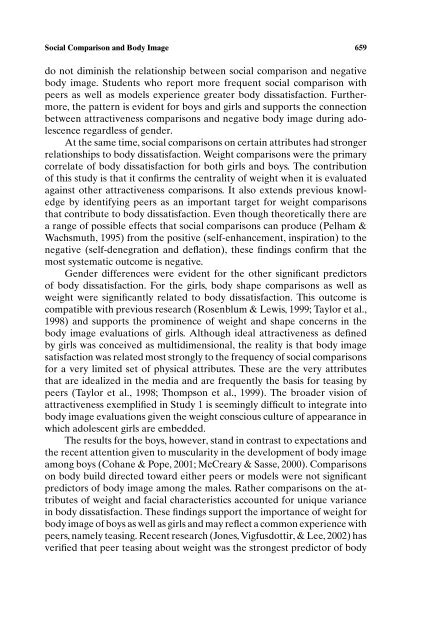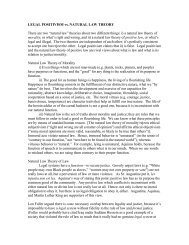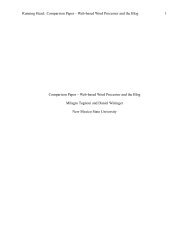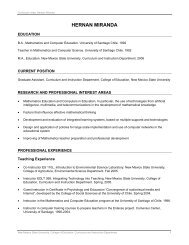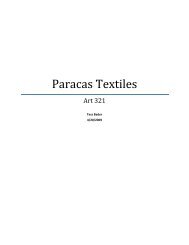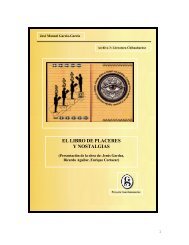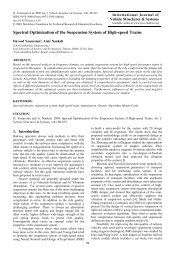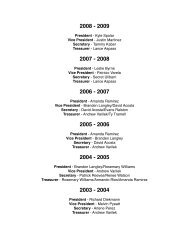Social Comparison and Body Image: Attractiveness Comparisons to ...
Social Comparison and Body Image: Attractiveness Comparisons to ...
Social Comparison and Body Image: Attractiveness Comparisons to ...
You also want an ePaper? Increase the reach of your titles
YUMPU automatically turns print PDFs into web optimized ePapers that Google loves.
<strong>Social</strong> <strong>Comparison</strong> <strong>and</strong> <strong>Body</strong> <strong>Image</strong> 659<br />
do not diminish the relationship between social comparison <strong>and</strong> negative<br />
body image. Students who report more frequent social comparison with<br />
peers as well as models experience greater body dissatisfaction. Furthermore,<br />
the pattern is evident for boys <strong>and</strong> girls <strong>and</strong> supports the connection<br />
between attractiveness comparisons <strong>and</strong> negative body image during adolescence<br />
regardless of gender.<br />
At the same time, social comparisons on certain attributes had stronger<br />
relationships <strong>to</strong> body dissatisfaction. Weight comparisons were the primary<br />
correlate of body dissatisfaction for both girls <strong>and</strong> boys. The contribution<br />
of this study is that it confirms the centrality of weight when it is evaluated<br />
against other attractiveness comparisons. It also extends previous knowledge<br />
by identifying peers as an important target for weight comparisons<br />
that contribute <strong>to</strong> body dissatisfaction. Even though theoretically there are<br />
a range of possible effects that social comparisons can produce (Pelham &<br />
Wachsmuth, 1995) from the positive (self-enhancement, inspiration) <strong>to</strong> the<br />
negative (self-denegration <strong>and</strong> deflation), these findings confirm that the<br />
most systematic outcome is negative.<br />
Gender differences were evident for the other significant predic<strong>to</strong>rs<br />
of body dissatisfaction. For the girls, body shape comparisons as well as<br />
weight were significantly related <strong>to</strong> body dissatisfaction. This outcome is<br />
compatible with previous research (Rosenblum & Lewis, 1999; Taylor et al.,<br />
1998) <strong>and</strong> supports the prominence of weight <strong>and</strong> shape concerns in the<br />
body image evaluations of girls. Although ideal attractiveness as defined<br />
by girls was conceived as multidimensional, the reality is that body image<br />
satisfaction was related most strongly <strong>to</strong> the frequency of social comparisons<br />
for a very limited set of physical attributes. These are the very attributes<br />
that are idealized in the media <strong>and</strong> are frequently the basis for teasing by<br />
peers (Taylor et al., 1998; Thompson et al., 1999). The broader vision of<br />
attractiveness exemplified in Study 1 is seemingly difficult <strong>to</strong> integrate in<strong>to</strong><br />
body image evaluations given the weight conscious culture of appearance in<br />
which adolescent girls are embedded.<br />
The results for the boys, however, st<strong>and</strong> in contrast <strong>to</strong> expectations <strong>and</strong><br />
the recent attention given <strong>to</strong> muscularity in the development of body image<br />
among boys (Cohane & Pope, 2001; McCreary & Sasse, 2000). <strong>Comparison</strong>s<br />
on body build directed <strong>to</strong>ward either peers or models were not significant<br />
predic<strong>to</strong>rs of body image among the males. Rather comparisons on the attributes<br />
of weight <strong>and</strong> facial characteristics accounted for unique variance<br />
in body dissatisfaction. These findings support the importance of weight for<br />
body image of boys as well as girls <strong>and</strong> may reflect a common experience with<br />
peers, namely teasing. Recent research (Jones, Vigfusdottir, & Lee, 2002) has<br />
verified that peer teasing about weight was the strongest predic<strong>to</strong>r of body


